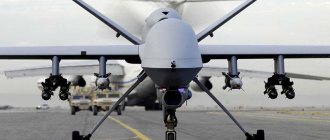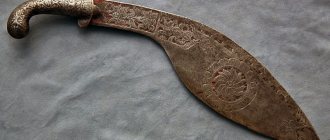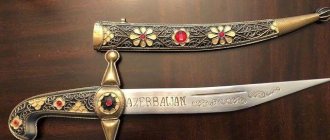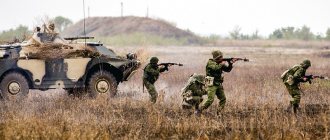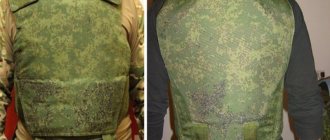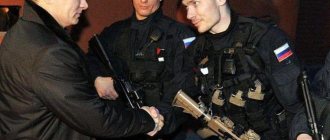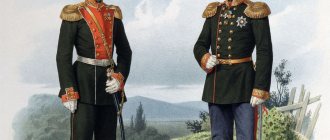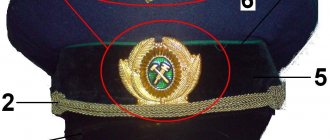Edged weapons have accompanied man for more than one millennium. And we are talking not so much about swords and other large blades, but about knives. Despite their significantly smaller size, it is even more likely thanks to them that knives have always been actively used to destroy the enemy both on the battlefield and during all kinds of secret operations. Initially, sharpened fragments of bones were used, then, after mastering metalworking technologies, metal versions began to be made.
Knife Typhoon, Art. U8, Elastron handle Semin 2,695 for 1 piece. Hunting knife H-161K Spike, elastron, camouflage, plastic sheath Nozhemir Nozhemir 1,990 for 1 piece. Knife Minesweeper Semin 3,035 for 1 piece. Knife H-214K Knifemir for 1 pc. Knife “Condor-3” 31933 Kizlyar 3,445 for 1 piece. Knife Raven-3, 31633 Kizlyar 4,055 for 1 piece. Tactical knife “Senpai” kraton, AUS8, satin, handle and sheath black Kizlyar Supreme for 1 pc. Knife “Maximus” D2 Kizlyar Supreme 5,995 for 1 piece.
Blades are included in the standard weapons of most states, including those with access to the most advanced weapons, to this day. The unique characteristics of a combat knife make it much more than just a means of eliminating the enemy. At the very least, this is a very practical and reliable tool that can be used for a wide variety of jobs. In addition, each combat model of bladed weapons is a true work of engineering art. Therefore, collectors are zealously interested in such products.
Of course, as with any other professional weapon, the circulation of combat blades is strictly controlled by the state. However, with permission, any citizen can buy such a knife. The only thing you need to remember: for violating Article 222 of the Criminal Code of the Russian Federation, which regulates the storage, carrying and use of bladed weapons in Russia, you face liability in the form of imprisonment for a term of 4-8 years.
Not every knife is a combat knife
First of all, a knife that has been officially adopted into service by a particular country can be considered a combat knife. In Russia these are the blades “Cobra”, “Antiterror”, “Katran”, etc. As a rule, each model has its own affiliation with a specific type of troops and a strictly individual set of technical characteristics. However, we can highlight the general characteristics of a combat knife:
The length of the blade is at least 10 cm. With a shorter length, the effectiveness of its use will be less. The total length of such knives ranges from 18 to 30 cm. It makes it easier to reach the enemy, ensures penetration into any vital organs and at the same time does not create problems when wearing and removing from the sheath.
However, earlier the size of military blades could have been much larger. The legendary combat knife of antiquity, Skramasax, actively used by the Germans, had a half-meter blade and a total length of about 70 cm. It was a terrible melee weapon, which, if successfully hit by an enemy, almost always became fatal.
There are other characteristic, but less obvious characteristics:
- The hardness of the blade here should be at least 47-55 HRC, which is ensured by the use of steels with the appropriate properties. The highly hard blade easily passes through thick clothing, and is often capable of pushing apart the fibers of Kevlar, from which protective vests are made.
- The profile of the handle of a combat knife is never round - it can only be oval or egg-shaped. This is explained by the fact that such an irregular shape fits more conveniently in the palm of your hand. In addition, you can quickly and without looking determine by the position of the handle exactly how the blade is positioned. And in battle, the saved fractions of a second can cost your life.
- The handle always has a non-slip coating. In modern models, plastic linings are used for this - they are reliable, practical, and durable.
- Sharpening a combat knife is never one-sided. The edges of the blade are sharpened either evenly or to 2/3 of the length. The last one is the so-called the so-called one-and-a-half sharpening, used in many combat knives of the Russian army, in particular, in “Vityaz”, “Gyurza”, “Caiman”. This is a purely practical consideration - there is no need to think about which side of the knife is working. And this again saves valuable time. At the same time, the aforementioned Skramasax was sharpened only on one side, although given its dimensions this did not play a special role.
- The shape of the blade corresponds to the specific purpose of the knife. The most effective option for close combat is a leaf-shaped blade with a variable sharpening angle. This knife is convenient for inflicting both stab and cut wounds.
- The width of the combat blade is on average 25-30 mm, which allows you to sharpen the blade at a smaller angle. And this improves the cutting properties of the knife. Additionally, the wider the blade, the larger the puncture wound it will leave.
- An important feature of a bladed weapon is a pronounced limiter, into which the fingers gripping the handle rest. On the one hand, it protects the fighter’s hand from slipping and cuts. On the other hand, the limiter plays the role of a stop, helping to more effectively apply muscle force to the blade. At the same time, the shape and dimensions of this structural element are always clearly verified and correlated with other dimensional characteristics of the knife.
- The weight of knives officially in service is 200-300 grams. Experience shows that this is the optimal range. Less weight reduces the lethal efficiency of the knife, which would have to be compensated by one’s own efforts. Heavier blades would be much less convenient to wield in combat conditions.
- The weight distribution of knives that fall into the category of edged weapons is adjusted in such a way that the center of gravity is shifted to the handle, and not to the sharp end of the blade. This helps you use it faster and more efficiently.
Subsequent modifications of the scout knife
Many knife manufacturers produce modern replicas of the famous army knife HP-43 “Cherry”. Authentic specimens enjoy constant interest among collectors. The only thing that confuses us is the circumstances of its appearance, which have not been fully established to this day.
Taking into account the experience gained, in 1943 the 1943 model NR-43 reconnaissance knife was adopted for service. So says one of the versions. It is based on the following facts:
- several photographs with the stamp “ZiK 1943” plus unsubstantiated allegations;
- the appearance of knives with the stamps “IMZ 1945”.
However, an investigation conducted by enthusiasts revealed that it does not correspond to the facts. Reasons for revising the history of appearance:
- plastic handles. There was no such material in Zlatoust during wartime;
- plastic was used exclusively for award and general weapons;
- plastic blanks were delivered from Novosibirsk and turned by hand; they did not know how to stamp;
- there is no information about the HP-43 in the archives;
- there was no opportunity in Zlatoust to switch to the production of new products in 1943.
The production technology, according to experts, dates back rather to a later time. “Cherry” was first mentioned during the Afghan War. Then he was spotted in other hot spots. Such a mystery creates even more interest in the knife when it appears.
The only reliable information is the history of the unusual name. The stylized capital letter P, when turned upside down, resembles a cherry. Hence - “Cherry”.
The total length of the product was 270 mm with a weight of 150 g. The crosspiece was changed to a straight one, the blade was lengthened by 6 mm, to 158 mm. The width has decreased to 17.17 mm with a thickness of 2.6 mm. Otherwise, the blade completely copied the HP-40. The shank now has an M3 thread for installation.
The handle, made of a new material at that time - plastic of different colors, was pressed with a nut.
The sheath, unlike the wooden one of its predecessor, is made of durable leather.
When in the 50s, the undeservedly little-known gunsmith German Aleksandrovich Korobov was working on the TKB-517 assault rifle, the main competitor of the AKM(a), he took the HP-40 as the basis for the bayonet-knife. When looking at the photograph, the characteristic shape of the legend immediately catches your eye.
Polish gunsmiths, using the Soviet model as a base, created their nóż szturmowy wz.55 - or translated as an assault knife of the 1955 model. It was distinguished by its blade fastening and steel sheath.
Yugoslavia, instead of a bayonet for the M56 assault rifle, used the M1951 combat knife, which differed from the Soviet prototype in the shape of the handle and the thickness of the blade. For over twenty years, the Czechoslovak company Mikov has been producing combat knives Útočný nůž vz. V07. A different bevel shape, a flat handle and a leather sheath distinguished the company's products from the scout knife.
A worthy grandson of the HP-40 can be called a “special reconnaissance knife” or simply NRS, created on the basis of an order from the KGB of the USSR and the Ministry of Defense.
It was developed at TOZ under the guidance of master gunsmith Rafail Khlynin.
The main work was carried out on the handle of the blade, where the firing mechanism was squeezed. Unlike the ballistic knives of the Soviet GRU special forces described by Rezun-Suvorov in Aquarium, shooting knives were actually in the sabotage units of the USSR.
The word “shooting”, used in some sources, is erroneous. According to the passport, the product is called a “special scout knife.”
The blade is 158 mm long, with a one-and-a-half sharpening, and a file is placed on the remaining part. It is necessary to cut slings, wires and wires, including those under voltage up to 400V.
The handle has a cavity to accommodate the firing mechanism and the barrel, which is fixed by turning the butt plate of the handle.
Its length is 60 mm, the barrel has 6 grooves. For shooting, a special SP-3 cartridge is used, with a caliber of 7.62 mm; this cartridge is designed for the MSP silent pistol.
The firing mechanism, less commonly called the trigger mechanism, consists of:
- lever, its task is to cock the hammer;
- striker mechanism;
- safety device against accidental release;
- release key.
Corrugated plastic cheeks cover the handle. Loading is done by removing the barrel. The weight without sheath and charge is 325 grams, which is quite heavy, which makes it uncomfortable to wear. They shoot from the LDC with the blade turned towards themselves. The shot is silent and can even be fired underwater.
Despite this, the knife was rarely used as a shooting knife. Since the units often did not have enough cartridges for it. In addition, the use of the shooting mechanism of the scout knife is truly unique. Yes, and you can use it effectively at a distance of no more than 3-5 meters.
With the adoption in 1983 of a silent complex with a PSS pistol and an SP-4 cartridge from TsNIITOCHMASH, engineers G.A. Savishchev, I.F. Shedlos and V. Ya. Ovchinnikov, the opportunity arose to modernize 6P25.
The result was the creation of NRS-2.
Converted to a more powerful cartridge and slightly heavier (360 g), “grown” by 2 mm and equipped with a more successful front sight, the 6P32 knife is still used by GRU units and special forces of the Russian Guard.
Varieties of combat knives according to blade shape
The most important element of any combat knife is its blade, since it determines the main characteristics and purpose of the weapon. In turn, the main attribute of the blade is its shape. And here are its variants used in the manufacture of combat edged weapons:
- Tanto. Japanese fighting knives are traditionally made in this form. It has been used for centuries, but is currently experiencing a real boom. The main advantage of Tanto is the massiveness of the blade, which is preserved along its entire length and provides the knife with high reliability and extremely resistant sharpening. With such a blade you can break through strong obstacles and repel enemy attacks. The sharpening can be wedge-shaped or concave. Another well-known representative of Japanese sharpening is the Austrian combat knives Eickhorn Kampfmesser, which are in service with the armies of many European countries.
- Bowie. Another classic option that has still not lost its relevance. American combat knives of the 19th century were also made in this form. A characteristic feature is the tip, which in its profile resembles a duck’s beak. In this case, the blade itself can be either straight or curved. The strength of Bowie blades due to the concave line of the spine is lower than that of Tanto, but it also copes well with utilitarian tasks. In combat, such knives deliver mainly stabbing blows - the sharp nose of the blade penetrates tissue perfectly. This feature of Bowie's concept is reminiscent of a traditional dagger.
- Drop Point. This is not a purely combat knife, but rather a wide-profile tool, since it is characterized by low aggressiveness and significant strength. Its blade has a drop-shaped shape and, in most cases, one-sided sharpening. In appearance and in terms of their use, they are similar to hunting ones.
- Dagger. In its classic design, it is a symmetrical double-edged knife with a light and relatively thin blade and a 4-way sharpening, specializing in piercing blows. Excellent for the role of a tactical weapon in close combat, as it allows you to easily make movements of all kinds. The dagger is completely unsuitable for the role of a tool.
- Spear Point. The shape of such a blade is similar to the tip of a spear, is reliable and can withstand high loads. The butt is curved upward, so the blade remains massive throughout its entire length. Sharpening is usually one-sided; the butt is supplemented with a blende. The tip is located almost exactly on the horizontal center line, which makes Spear Points a good weapon. Such knives do not cope very well with utilitarian tasks.
- Hawkbill. Specific knives with a sickle-shaped blade, which is perfect for cutting cables, belts, etc. It is rarely used in open combat, since it is completely unsuitable for piercing blows. At the same time, such a blade can be used like a claw or a hook - it is capable of delivering powerful hook strikes and circular strikes.
Each of the considered blade shapes can have different variations that emphasize certain performance characteristics.
A daily boost of fighting spirit!WARHEAD.SU
I would, of course, like to give a detailed—about ten pages long—review of all the samples used in the USSR and its satellites.
(Photo: Julius)
But we have to restrain ourselves, so let’s compare the new product with the model currently in service.
6X5 is a relatively recent product, it was adopted in 1989 and, in my opinion, is a very successful version of a modern bayonet knife. It traditionally does not shine with cutting qualities - but this is perhaps the only complaint about it.
On the same topic
What types of bayonets are there: from a club to an opener
Lightweight (due to glass-filled polyamide, we managed to reduce the weight by 50 grams compared to the previous 6X4), it holds the load well during a piercing blow, the handle is grippy, the file on the butt actually works on metal - you can easily open a tin can (and with the same bayonet from a can eat), cuts wire, is securely attached to the weapon, does not fall out of the sheath - what else, excuse me, do you need?
But no - from the dense forum bushes of the Internet with enviable frequency comes a creaky song about moral obsolescence: “Ah-ah-ah, what is this: a soldier needs a normal knife, but this one doesn’t cut at all! Keeping such bayonets in service is a whole act of sabotage aimed at reducing the defense capability of the Russian army!”
Well, okay, they wanted a new bayonet - here you go, please...
The current 6X9 is included in the “Ratnik” equipment set - in addition to the “universal knife 6E6” (a product that is as charismatic as it is clumsy and inconvenient).
Fortunately, this time the development of the “cold” new product was carried out by , which is not very well known among knife lovers, but produced a relatively good result. The 6X9 is available in three versions: civilian (tourist knife with the most trimmed guard), combat (developed guard) and, in fact, in the bayonet-knife version (the guard has a ring for putting on the DTK, and there is a latch in the back of the handle).
The blade inspires respect: after all, it’s five millimeters thick. The steel, by the way, is far from the worst: the domestic 95X18 is close in properties to the classic “knifemaker” 440C. Low-rust, with good wear resistance, able to hold an edge well, durable and flexible. The fuller on the blade increases fracture strength, the dark coating improves corrosion resistance and prevents unmasking glare. The top of the plastic handle is metal, massive, with a “glass breaker” protrusion.
The designers decided to abandon the hole in the blade (this element makes the knife more fragile), but they decided to retain the function of cutting wire. To do this, we had to complicate the design of the plastic sheath: now a special cutting lever is attached to it. The scabbard itself, by the way, has become composite, the halves are connected using seven bolts. In this case, the “bare” sheath cannot be secured to the uniform; an external cover with a clasp, sewn from a sling, is required.
So far everything seems to be fine. However, there are also disadvantages. Firstly, the weight: the 6X9 complete with sheath pulls as much as 700 grams (the standard 6X5 weighs only 363 grams - almost half as much). Secondly, the price. 6X9 is offered for sale at prices ranging from 8,000 to 11,000 rubles. At this cost, I don’t see any prospects for the product to become the main model of the Russian army.
In my unenlightened armchair expert opinion, it’s still not worth combining the properties of a combat knife and a bayonet. Flies - separately, cutlets - separately, and for an ordinary soldier, a folding multi-item knife is generally better suited for every day.
So is it possible to create a bayonet-knife that would equally satisfy the requirements for a knife and a bayonet? Was it light, strong, sharp and cheap? Today, apparently not. We take traditional materials - the product either does not cut or breaks. We use super steels - we lose cheapness. Whatever one may say, something suffers and the compromise does not look good. Perhaps in the distant, distant future, new materials will be created for lightsabers - some kind of composites and superplastics - by using which, the military will finally get their mythical ideal bayonet-knife. Only by that time bayonet fighting itself will be removed from training, and the weapons of the sentries in the honor guard will be decorated, for example, with LEDs. Or holograms. It's beautiful, well.
Classification by blade sharpening shape
To a large extent, the type of sharpening influences the ability to use a particular knife in various situations. In particular, it determines the permissible loads on the blade. Today, in the production of military edged weapons, the following sharpening options are used.
Wedge-shaped
A traditional variety in which the blade expands smoothly and evenly upward from the cutting edge. This sharpening is highly durable and practical, therefore it is used on combat knives with a universal profile. By changing the angle of the wedge, you can increase the strength of the blade or improve its cutting qualities.
Dolovaya
It is used on narrow and extremely thin blades, which is why it is also known as a razor blade. To ensure mechanical strength, the blade is complemented by a massive butt, otherwise the knife would be too fragile. A knife with a fuller sharpening is exclusively a cutting tool; it should not be used for utilitarian purposes.
Chisel
It resembles a wedge-shaped sharpening, but the bevel here runs only along one side of the blade - the other side remains strictly vertical. The chisel sharpening became especially widespread among Japanese knife makers. Its main advantage is its high practicality and durability.
Convex
Combat knives do not receive such sharpening very often, since it is characterized by a chopping effect rather than a cutting one. At the same time, it is perfect for blades used as tools. Therefore, you can equip your ammunition with any of the above knives - and supplement it for greater practicality with a cleaver with a double-sided sharpening of a convex type.
The most popular models of modern combat knives in Russia
The modern knife industry produces many models of knives that claim to be combat knives, both edged weapons manufactured for special forces of the Russian army, and civilian models, which are considered tourist and skinning knives according to GOST. Here is a list of the most popular models:
- The “Lynx” knife from the AIR company from Zlatoust is a model developed by order of the Moscow SOBR. This knife has a dagger-shaped blade and is one of the knives that are designed exclusively for combat. It will be quite difficult to perform household functions with this knife;
- The knife “DV-1” and “DV-2”, unlike the “Lynx”, can be used as a tool. These models (DV-1 from DV-2) differ only in the length of the blade. This knife can withstand enormous loads, so it is useful for working in difficult conditions;
- The “Punisher” knife is a very charismatic model, made by order of the Russian FSB. In addition to military models, there are also civilian versions without a guard;
- The knives of the Vityaz series were manufactured to order from BKB Vityaz. This model is a typical special forces knife. A heavy blade, due to the shape of the blade and weight, easily penetrates the opponent’s body;
- An interesting model is the Werewolf folding knife. This model is equipped with several tools that are located in the knife handles. This knife is positioned as a tool, but in case of danger it will serve quite effectively as a weapon.
There are many more modifications of Russian-made combat knives, but you need to remember that the knife is used quite rarely in the modern army, and then only as a household tool. Ordinary citizens can purchase civilian versions of almost all models of Russian combat knives.
Possibility of using combat knives
For a soldier, a knife serves not only as a tool for silently eliminating the enemy, but also as a multifunctional working tool. Moreover, in most cases this is not a forced measure, but an opportunity initially built into the design. And here are just some of the possible ways to use a combat knife.
Preparing a firing position
Accuracy and efficiency of actions are important here. The fighter must clear as quickly as possible the space for firing, both natural, for example, tree branches and bushes, and artificial, for example, curtains, if the firing point is located in a building. In some cases, you can use a knife to remove excess soil, but only high-strength blades are suitable for such work.
Freedom from various hindrances
The knife will help you quickly cut tangled lines and ropes used when landing and descending on vertical surfaces. To do this, it is better to use special knives with a saw edge on the butt.
Clearing underwater space
For combat swimmers and paratroopers, sabotage groups and other units in contact with water, a knife often becomes the only effective weapon. With its help, you can not only silently, without attracting attention, eliminate enemy submariners, but also quickly get out of fishing nets. The latter are often found in coastal waters, and getting out of them is quite difficult. It is not easy to break a strong fishing line, but a sharp knife copes with this task perfectly.
Combat knives of elite units of the Russian Armed Forces
Edged weapons are in service with almost every type of Russian military. And if ordinary blades are for the most part mediocre, then the knives of the elite of the RF Armed Forces definitely deserve attention.
Special forces knives
For special forces, blades are offered that are characterized by maximum simplicity and reliability of design. At their core, these are survival knives, which often become almost the only “working tool” of a special forces soldier. A characteristic feature of such products is a shorter and wider blade, intended primarily for delivering cutting blows. The sharpening can be very different: for the “Eager” it is one-sided, for the “Gyurza” it is one-and-a-half, and for the “Shaitan” it is double-sided.
Lynx
This model was created specifically for the Moscow SOBR by Zlatoust engineers. The Lynx is produced in 3 variations - combat, award and civilian. The second differs from the first only in the presence of a gold-plated coating. The civilian modification receives a simple one-sided sharpening, and its center of gravity is slightly shifted.
chastener
Designed for use by security forces of the FSB and is produced in 2 variations. "Vzmakh-1", officially in service, has a serrated (wave-shaped) sharpening in the root part. In the “Maestro” variation, the serrator runs only along the upper edge of the blade with a black or camouflage anti-reflective coating. “The Punisher” in any version is distinguished by a wide, powerful blade that can be used for various tasks.
DV-1 and DV-2
This development was created specifically for special forces units based in the Far East. Both versions are powerful, heavy and durable, and are designed to withstand high and long-term loads. DV-1 received a spear-shaped blade with a partially sharpened butt.
DV-2 is distinguished by its larger dimensions and more carefully designed ergonomics.
Storm
A prototype developed for the needs of the Marine Corps. Therefore, the knife is extremely resistant to the negative effects of water. However, unlike many other models designed for combat swimmers, this model cannot be called universal. The edges of its blade do not have saw edges, so the Storm's specialization is narrow - exclusively close combat.
Knight
It is in service with many Russian special forces units and is available in 3 variations. A characteristic feature of the entire line is a massive and large blade and a fairly narrow blade. This helps to make the blow more inert, increase the penetration ability of the knife and at the same time make it lighter.
Anti-terror
Another knife created specifically for the security forces of the FSB. The blade is made in a petal shape, which improves the cutting properties of the knife and makes it possible to effectively use its entire working area. “Antiterror” is characterized by excellent penetrating abilities, and thanks to the notch in the root part of the blade, it received an elongated cutting edge without increasing in size.
Katran-1
An extensive line, adopted recently. Katran-1 is the most modern knife for combat swimmers of the Russian army. He received a blade with a one-and-a-half sharpening, and on the butt it has a wave-like shape. In addition, in the end of the blade there is a segment of serrated sharpening and a special hook. These additions allow you to quickly cut nets, ropes and other obstacles hidden in the water. The handle is made of rubber. Metal surfaces are protected from corrosion by black chrome plating.
Katran-1-S is a modification for land use. It differs from the marine version in a different type of steel, anti-reflective coating and leather handle.
Katran-45 is a modification developed by personal order of the 45th Special Forces Brigade. The butt has an insert for sawing metal. The knife is covered with an anti-reflective or camouflage coating.
Akela
Created as a working police knife for SOBR soldiers. Characteristic feature: compact size, designed for use in cramped urban environments. The blade is double-edged, dagger-type, coated with black chrome, which does not reflect light. The handle is rubber, with perforation for a lanyard.
SMERSH-5
A combat knife specifically for the Russian GRU in the canonical Finnish style. It is based on the concept of the legendary HP-43 blade, which was actively used back in the Great Patriotic War. Modern SMERSH has a blade with high penetrating ability. The powerful upper part of the guard provides additional pressure, thanks to which SMERSH-5 is able to cut objects of high hardness.
Explosive technician
A large, massive knife with an 18-centimeter blade and developed by special order of FSB sappers. Combines the functionality of a combat knife, a working tool and a survival knife. Characteristic features: symmetry of the blade, even sharpening along the lower edge, serrated with a fine pitch along the spine. The handle is complemented by a powerful metal pommel, which can be used both as a striking weapon and as a replacement for a hammer.
Elf
Developed by order of the GRU of the Moscow Region, a knife with a narrow anti-reflective blade, on the butt of which there is a powerful serrator. A characteristic feature of the “Elf” is a hollow handle with a depth of 96 mm and a diameter of 22 mm. This solution allows us to classify this model as a survival knife.
Basurmanin
This knife has the same shape as army daggers, but its sharpening is one-sided. This model, like the Elf, can easily be classified as a survival knife. Its handle is also hollow, but the main highlight of the “Basurmanin” is the sheath. They come equipped with an extensive set of tools, including wire cutters, saw blades, screwdrivers and a wrench.
Werewolf
Another combat knife that also falls into the category of survival models. In its normal state, it has a powerful teardrop-shaped blade with a large serrated on the upper edge of the tip and a small saw at the lower root part. When folding the butterfly handle, access to a nail puller, 2 more sawing edges, a can opener and other tools is available.
A little about the history of knives
For most of human history, it was edged weapons that decided the outcome of armed conflicts. And, although the knife usually served as a secondary weapon, mention of it can be found in dozens of historical chronicles and chronicles.
Man learned to make knives back in the Stone Age, and since then this tool has been his constant and faithful companion.
The beginning of human use of metals and the development of metallurgy led to the creation of even more effective weapons, including knives. It should be noted that at the beginning of the Bronze Age, man first began to make metal tips for arrows and spears, as well as bronze knives. Things didn’t come to swords right away: they learned to make high-quality metal weapons with a long blade much later.
Technologies for smelting iron and producing high-quality steel suitable for making bladed weapons developed faster in the Middle East and India. It was there that they were the first to learn how to make damask steel and forge Damascus steel.
It should be noted that contrary to the prevailing stereotype (mainly thanks to cinema), in Antiquity and the Middle Ages most of the troops were armed with spears, bows, axes and throwing weapons. High-quality edged weapons with a long blade were not easy to make and were very expensive. In addition, working with a sword required great skill, which took years to acquire.
It must be said that during a clash using dense combat formations, the spear and javelin were much more effective than chopping weapons (sword, axe). Even the famous short Roman sword (gladius) was used quite rarely. And combat knives were very rarely used in such battles.
Combat knives were generally rarely considered as weapons of professionals. Much more often they were armed with peasant (or other) militia, along with other types of agricultural tools. In addition, the use of massive armor made the use of combat knives not very effective.
The world of ancient and medieval edged weapons is amazingly rich and interesting. In addition to the more or less familiar European weapons, there are also the Middle East, India, China and Japan, which have rich traditions in this area. But the purpose of our article does not include a detailed study of this issue; to do this, you need to write more than a dozen books. However, several important historical points that seriously influenced the further development of combat knives need to be highlighted.
Most important was the advent of firearms, which made solid armor ineffective. This led to the rapid development of edged weapons, including various types of combat knives. In addition, it was during this period that the first European mass regular armies appeared. A soldier with a heavy and inconvenient musket or rifle also needed to be armed with a bladed weapon, preferably with a more convenient short blade. In the 17th century, various types of cutlasses became widespread, used by both musketeers and artillerymen.
In addition to fighters armed with firearms, a significant part of the army were pikemen, one of whose tasks was protection from cavalry attacks. Reloading the first types of firearms was not easy and quite lengthy. In the 17th century, infantry began to use hunting daggers or baguettes, which, after firing, could be inserted directly into the barrel of the weapon. This is how the first bayonets appeared on the battlefield, and an ordinary infantryman could do the work of a pikeman and effectively resist cavalry attacks. At the end of the same century, the baguinet received a new method of fastening, which allows the weapon to be reloaded even with an attached bayonet.
Bayonets are still in service with almost all armies of the world, although, of course, their role today has been practically neutralized. The heyday of bayonet fighting was the 18th and 19th centuries. There are a huge number of bayonet designs, they differ in length, blade shape, and method of attachment to the weapon. For several centuries, designers have strived to turn the bayonet into an effective combat knife and make it a convenient tool. Unfortunately, combining all these functions in one weapon is quite difficult.
